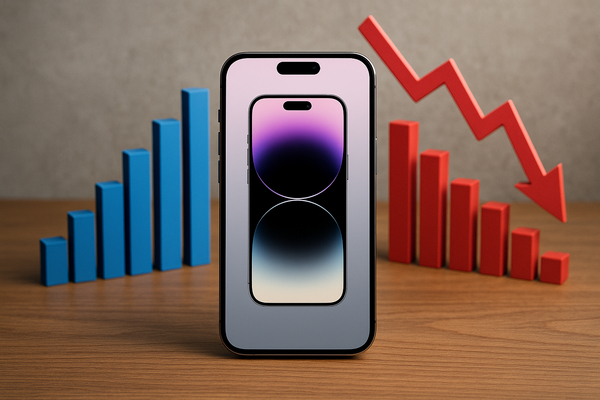
Apple (NASDAQ:AAPL) is driving a fresh market narrative after the iPhone 17 debut. The device is lifting sales and investor sentiment in the near term and is being cited as a potential trigger for a 2019-style year‑end rally. In the short term, demand and margin upside from iPhone 17 and high-margin Services are accelerating momentum in the U.S. and parts of Asia. In the longer term, regulatory moves in Europe and the U.K., slower Air demand and supply adjustments weigh on growth in those regions and emerging markets. Historic parallels to 2019 give context but outcomes will hinge on earnings, guidance and regulator action this quarter.
Demand, products and margin drivers: iPhone 17, Services and the supercycle thesis
Apple (NASDAQ:AAPL) headlines 24 distinct news items this cycle, centered on the iPhone 17 launch and Services strength. Multiple reports argue the iPhone 17 could ignite a supercycle — lifting unit sales and expanding hardware margins because higher ASPs and accessory attach rates are coming through. One preview argues AAPL is likely to beat fiscal Q4 estimates as iPhone 17 demand and Services growth accelerate ahead of earnings next week.
Services now account for nearly a third of Apple’s revenue in recent commentary, with reported gross margins approaching 75% for that segment. That mix shift matters: service revenue is recurring and lifts consolidated gross margin even if device growth moderates. Market cap headlines — Apple approaching $4 trillion after the iPhone 17 debut — reflect that interplay: product refresh demand front‑loads sales, while software and services bolster margin resilience.
Not all product signals are uniformly positive. Analyst notes and supply‑chain checks flagged weak initial demand for the iPhone Air. One report cited production cuts to under 10% of prior September volume, and TF International’s Ming‑Chi Kuo said iPhone Air demand fell short, prompting drastic production reductions. That split — very strong uptake for flagship 17 vs. weak appetite for Air — creates a bifurcated near‑term revenue mix and inventory tradeoffs across markets.
Regulatory and policy pressures: EU complaint, U.K. strategic market status and global scrutiny
Apple’s business is now moving inside a regulatory spotlight in both Europe and Britain. The company faces a complaint alleging violations of the EU Digital Markets Act. Meanwhile, the U.K. Competition and Markets Authority has designated Apple and Google with strategic market status for mobile platforms, a step that tightens oversight and could force changes to app‑store rules, payment options and data access.
Those moves have immediate local implications. In Europe, DMA enforcement can mandate changes to app distribution and fees that would affect Services and App Store economics. In the U.K., the strategic market status designation signals strengthened supervision and possible remedies that could reduce Apple’s control over the iOS ecosystem. Globally, tighter mobile rules raise the cost of doing business in regulated markets and create execution risk for certain monetization levers that have helped push margins higher.
The regulatory backdrop is a counterbalance to product momentum. If European and U.K. actions force Apple to open alternative app stores or change in‑app payment rules, Services revenue growth and margins could face headwinds. Companies operating across the U.S., Europe and Asia will watch enforcement timelines closely; for Apple, the timing and scope of remedies matter as much as the eventual policy outcome.
Market reaction, earnings calendar and investment context
Street attention is concentrated on Apple’s upcoming fiscal Q4 report. Several pieces highlight expectations that AAPL will exceed estimates on iPhone 17 demand and Services expansion. Morgan Stanley and other houses flagged an expected beat, while at least one analyst called the stock expensive despite the launch strength. The headline that Apple may repeat a 2019 year‑end rally has been used as a comparative frame: then, product momentum and buybacks helped drive a late‑year advance. Today, strong device sales plus a larger, high‑margin Services base are the analogous drivers.
Market sentiment, however, is fragile. Tech peers and macro headlines are in play. Microsoft (NASDAQ:MSFT) and cloud peers are drawing investor focus on AI and enterprise monetization, while Nvidia (NASDAQ:NVDA) and other chip names are dictating risk appetite across the sector. That linkage matters because a broad tech re‑rating or selloff can amplify moves in AAPL regardless of company‑specific results.
For traders and analysts the immediate checklist is clear: fiscal Q4 delivery, guidance on iPhone Air and 17 shipments, Services gross‑margin trajectory, and clarity on how regulators will proceed in Europe and the U.K. Each item has a measurable impact — shipment pace, reported margins, market cap movements and potential structural revenue changes — and will drive short‑term flows across regions including the U.S., Europe and Asia.
- Takeaway 1: iPhone 17 demand is currently the primary short‑term growth driver; it has pushed Apple toward a near‑term market cap milestone (~$4 trillion).
- Takeaway 2: Services now provide meaningful margin insulation — roughly one‑third of revenue and gross margins near 75% — making revenue quality higher than in prior device‑centric cycles.
- Takeaway 3: Weak iPhone Air demand (production cut to <10% of prior volume) introduces a regional and product mix risk that could temper upside estimates.
- Takeaway 4: EU and U.K. enforcement can change App Store economics and will be important for medium‑term Services dynamics.
- Takeaway 5: Earnings next week will be the decisive near‑term signal for how much of the launch strength is already priced into the stock.
The coming days will be heavy with data: quarterly results, analyst notes and regulatory statements. For now, Apple sits at the intersection of product momentum and policy scrutiny — a combination that is lifting optimism while creating measurable points of execution risk across markets.












